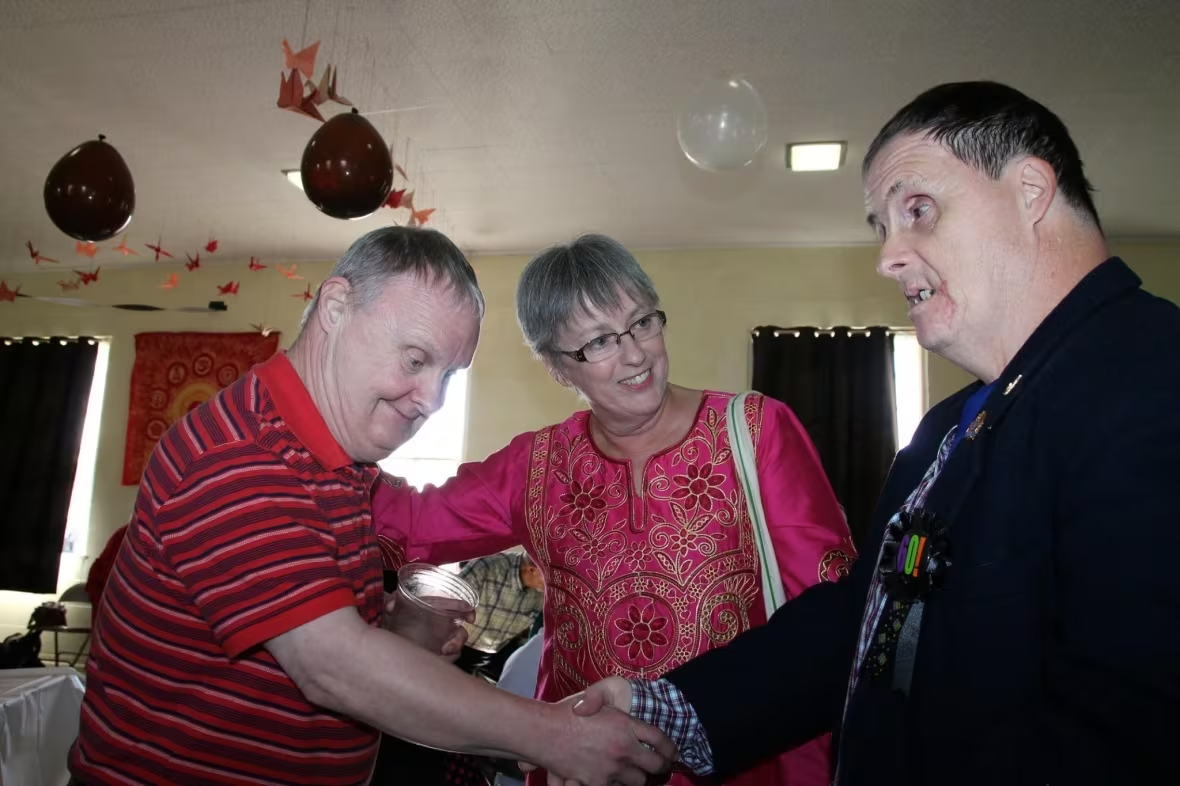Why people with Down syndrome are living longer than ever
New photo project celebrates doubling of life expectancy since 1980.

Adam Bauld looks at Hilary Gauld’s photos of Brigette, a 75-year-old woman with Down syndrome. CBC
Jon Tattrie, CBC News Nova Scotia September 4, 2023
People with Down syndrome are living longer than ever and an ongoing photo project aims to upend stereotypes about them.
Laura LaChance, the executive director of the Canadian Down Syndrome Society, says evidence shows an extraordinary growth in life expectancy over the last few decades.
“The research is showing us that life expectancy has more than doubled in the last generation, and where in the early 1980s you might expect a life expectancy of 25 years, now 60 is the average,” she says.
Many people who have Down syndrome also have a heart defect. In the past, it went undiagnosed and could cause death in infants and children. Today in Canada, more people are diagnosed early on and the condition is treated.
In the past, Canadians with intellectual disabilities often were compelled to live in large institutions from a young age. LaChance thinks the move to community and family living over the last 40 years has also led to longer and happier lives.
| Here I Am |
LaChance, whose 30-year-old son Kevin has Down syndrome, says that good news wasn’t reflected in the images she saw of people today.
“I think there still are some stereotypes to be broken, some myths and misconceptions to be busted about the ability and even the presence of individuals with intellectual disabilities as they age in the community.”
LaChance says she had the idea to work with photographer Hilary Gauld to showcase the lives lived by people with Down syndrome.
“I just felt there was a huge gap and a huge need to photograph people with Down syndrome in great light and in great environments and doing the things they do,” Gauld told CBC News.
However, budget limits kept the Here I Am cameras in central Canada. CBC decided to visit some Nova Scotians with Down syndrome to add to the images.
| Hitting his stride |

Adam Bauld works on his latest painting in his Halifax home. Robert Short CBC
Adam Bauld recently celebrated his 40th birthday in Halifax. He enjoys spending time with his parents and two brothers. He plays sports, including at the Special Olympics.
He works at Clearwater Seafoods in customer service and enhanced cleaning.
“I started in February 2005. And these are my long service awards — 10 years of service in 2015, 15 years of service 2020, during the COVID pandemic. And I also got a congratulation pack for service,” he says, showing his awards.
For the last decade, art has been a major passion. His paintings decorate his room.
“These paintings over here are like collage, a camp, abstract, a religious painting over there about Calvary and the Cross of Christ,” he says during a tour of his work.
He says some of his friends have Down syndrome and some don’t. “My experience is that God created every person in His image, whether it’s Down syndrome or not Down syndrome,” he says.
It’s a message shared by many people at L’Arche Homefires, a community of people with intellectual disabilities living in five houses in Wolfville, N.S. People here have friends without Down syndrome and friends with Down syndrome.
Cameron Cook weaves scarves, place mats and bags in his favourite colours. He also volunteers at the local fire department.

Cameron Cook works on his loom at L’Arche Homefires in Wolfville. Robert Short CBC

Brittany Bennett works on a new project at L’Arche Homefires in Wolfville. CBC

Gregory Moore enjoys theatre and weaving with bright colours. Robert Short CBC
The two founding members of L’Arche Homefires — Keith Strong and John MacNeil — both had Down syndrome.
Assistant Robert Rose supported Strong, who died in 2018, during his last years, and now spends his days with MacNeil.

John MacNeil and Keith Strong shake hands as Ingrid Blais looks on. Submitted by L’Arche Homefires
“They’ve been real teachers for us because we’ve had to learn with them as they’ve gotten older. And we have had to make changes around their changing health conditions,” Rose says.
“We try to create a safe, stable, and peaceful environment. A small support team is created to work with the core member so that there is staff consistency throughout the week. We have found that this greatly reduces the core member’s anxiety.”
Older people with Down syndrome often have to deal with Alzheimer’s disease and “accelerated aging,” meaning some will see physical, medical and cognitive signs of aging much earlier than what is expected for their age.
“This has been a learning process for everyone involved. The assistants have had to let go of their expectations and agendas and meet core members where they are,” Rose says. “As the elders in our community, our core members continue to teach us even when they are non-verbal.”

Robert Rose says he’s learned a lot about life from working with older people with Down syndrome. Robert Short CBC
MacNeil used to live in a busy part of his home, but moving to a quieter area proved more comfortable in his golden years. Now he sets the agenda for the day.
“That was a game-changer with John,” Rose says. “He was in a space where he felt safe. His behaviour, his anxiety decreased significantly. Now he’s in a place where people can visit him whenever he wants but he’s not near the flow of traffic in the house anymore.”
Rose said it’s the first job he’s ever had where he felt he could be completely himself — a lesson he learned from Strong and MacNeil.
“I think one of the things we’ve all realized is how important the elders are in our community. Even though they may be physically limited as they get older, their presence is palpable,” he says. “The real value is not so much what people are doing, it’s their being — it’s who they are. And that’s what I’ve seen come through as our core members have gotten older.”
The Here I Am project started with 13 images and grew. The Canadian Down Syndrome Society hopes to keep growing it and add it to photo databases so that journalists have a broader range of images to illustrate stories about people with Down syndrome.
The group also hopes to include people from a diverse range of backgrounds. In Canada, about 50,000 people have Down syndrome, and the project aims to capture as many of those faces as it can.
LaChance says it reminds all of us that people with Down syndrome have always been part of humanity. She cites research that may show some of this largely hidden history.
“Much of our history is learned from stained-glass windows or scribe accounts. And there was always a court jester; many of these images show the facial features of an individual with Down syndrome,” she says.
“Individuals with Down syndrome have been around forever and brought joy and happiness to the communities they lived in when they could.”
| Jon Tattrie, Reporter |
| Jon Tattrie is a journalist and author in Nova Scotia. |
![]() Source CBC News Nova Scotia
Source CBC News Nova Scotia
Also see
‘A man of hope’: L’Arche Homefires mourns founding member Keith Strong CBC
Edmonton model with Down syndrome to make Times Square debut CBC






